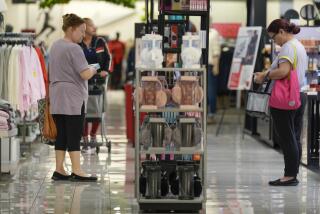Retail Sales for April a Show of Warmth
Balmy temperatures throughout much of the nation last month meant better-than-expected April retail sales, U.S. retailers said Thursday, with new spring clothes and outdoor equipment leading the way.
Although the market responded enthusiastically to the reports, sending many retail shares higher, financial analysts were reluctant to declare a sector turnaround. Many cautioned about sharp performance differences among retailers and continued economic pressures such as high energy costs.
“It was very uneven, and that’s not terribly comforting,” said Michael P. Niemira, an economist and retail analyst with Bank of Tokyo-Mitsubishi in New York. “I guess I still believe there is a second leg to the consumer slowdown that will probably unfold this summer.”
Some of the stock market enthusiasm probably came from a confluence of surprises: On top of a good retail sales report came an interest rate cut by the European Central Bank and news that first-time jobless claims last week fell by 41,000.
Retail analysts, however, said that much of the sales gain is related to March’s sales weakness, not renewed consumer vigor.
Bad weather in March kept shoppers from thinking too much about seasonal apparel and gear, meaning that by April, retailers benefited from pent-up demand when the mercury rose, several analysts said.
In addition, fashion trends were especially attractive to women shoppers, with healthy sales of halter tops and low-rise pants. Sales of men’s clothes, for the most part, were soft.
But even a good seasonal swing shouldn’t be taken as a change in consumer confidence, Niemira said.
“The results provide no clear definition of the current environment or for the outlook for May,” said Richard Church, a retail analyst with Salomon Smith Barney in New York. “We continue to see no signs the consumer is falling apart but stop short of concluding that April’s results spell the beginning of an uptick in consumer spending.”
Niemira reported a year-over-year April sales gain of 3.8%, compared with a 1.7% increase in March. Church also measured a 3.8% gain.
But a strong showing from some of the nation’s largest discount retailers tended to skew the numbers.
Wal-Mart Stores, the nation’s largest retailer, posted a 6.5% sales gain in stores open at least a year. Consumers clearly were continuing to take price into consideration, analysts said.
Goldman Sachs’ composite numbers included a 5% gain for the discount stores, compared with an overall gain of 3%; both figures are for stories open at least a year.
J.C. Penney Stores, another retailer large enough to skew sales figures upward across the group, reported a 3.8% increase in sales for stores open at least a year; Goldman Sachs had predicted a Penney increase of 1% to 2%.
Warehouse seller Costco reported its biggest gains since September, with a same-store sales gain of 6%.
Discount retailer Dollar General’s same-store sales were up 9.2%, compared with the previous year.
Same-store sales, or sales from stores open at least a year, are considered an important measure of a company’s ongoing, overall health because the number excludes new and closed stores.
Some of the discounters’ gains appeared to be the department stores’ loss. Goldman Sachs tallied department store sales as down 0.1% from a year ago. Nordstrom posted a same-store sales drop of 6%, May Department Stores saw sales fall 8.3%, and Dillard’s Department Stores also reported a 6% drop in sales.
Thursday’s reports offered Wall Street a few positive surprises, including a 6% sales gain at casual clothier Abercrombie & Fitch, which has struggled for the last year to regain momentum. Highflying Talbots, which has been a strong seller month after month, even when compared with last year’s already impressive gains, said sales grew 12.6%.
Kohl’s, among the retail sector’s strongest players, once again topped Goldman Sachs’ group, with a same-store sales gain of 12.7% over last year.
Other retailers with sales declines still were able to positively surprise Wall Street by posting numbers that weren’t as bad as some expected.
Limited and Intimate Brands had declines that analysts said could have been much worse. Limited reported a overall sales decline of 1%, beating an estimated drop of 7%; its apparel stores, including Lerner and Lane Bryant and its namesake Limited, gained 5%, compared with the same stores a year earlier.
Likewise, Intimate Brands, the parent of Victoria’s Secret and still majority-owned by Limited, fell off by 8% in same-store sales, as opposed to the 13% decline some analysts expected.
More to Read
Inside the business of entertainment
The Wide Shot brings you news, analysis and insights on everything from streaming wars to production — and what it all means for the future.
You may occasionally receive promotional content from the Los Angeles Times.










